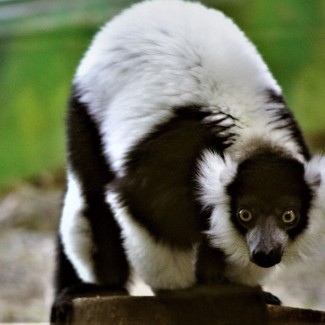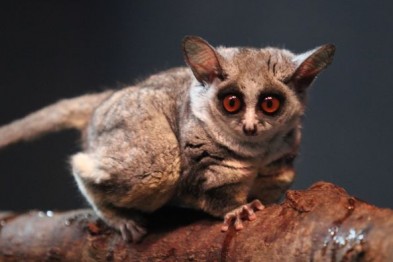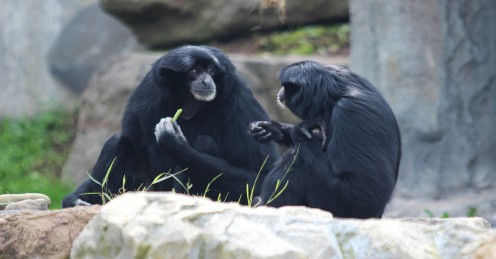International Primate Day
International Primate Day
Here at the Rosamond Gifford Zoo and at many AZA institutions we are celebrating International Primate Day!
The International Union for Conservation of Nature (IUCN) recognizes well over 600 primate species and subspecies -- and counting!
Nonhuman primates, our closest biological relatives, play important roles in the livelihoods, cultures, and religions of many people, and in the ecological balance of different habitats. They directly contribute to the regeneration of tropical forests and maintaining healthy ecosystems.
An important fact is that primates are closely linked to the diversification and spread of angiosperms (plants that have flowers and produce fruits like herbaceous plants, shrubs, grasses, and most trees), a principal source of food (pollen, nectar, fruits, and seeds) for countless animals including humans.
The loss of primate species, in part due to overhunting, habitat destruction and disease is a crucial issue for many plants whose life depends on them.
Here at the Rosamond Gifford Zoo we have six different species of primate: siamang apes; two types of Old World monkeys, patas monkeys and colobus monkeys; the critically endangered golden lion tamarin; and two types of prosimians, Southern lesser galagos and black and white ruffed lemurs. Throughout this week, we will share highlights of each species so you can learn all about them, as well as ways to contribute to their conservation.
Patas Monkey
Happy International Primate Day! We would now like to introduce you to our Patas monkeys. The zoo currently has three females on exhibit in our Social Animal building. Sara, our most dominant female, is 12 years old and came to the zoo in 2010 from ZooTampa at Lowry Park. Our two younger patas, Kasi and Etta, are sisters born a little under a year apart. Etta celebrated her third birthday on August 1st and Kasi will celebrate her fourth birthday on September 16th. Patas monkeys are a ground dwelling primate native to the open grasslands of equatorial Africa. Typical troops consist of one male, multiple females, and their offspring. While the males are the protectors, the females form the core of the troop and create a dominance hierarchy between individuals. They are the fastest primate in the world, reaching speeds up to 34 miles per hour! If they aren’t playing and running, you can often see the patas monkeys foraging for food, grooming, or napping. Come visit our patas monkey troop the next time you are at the zoo. If you don’t see them in the building, they may be running around outside on Primate Park!
Golden Lion Tamarin
 Golden lion tamarins are a small primate native to the coastal forests of southeastern Brazil. They get their name from the long golden colored hair that frames their face. This social species can be found in families consisting of a breeding pair and one or two litters of offspring. When babies are born, typically twins, the entire family will aid in raising the young. Tamarins are omnivores and will use their long slender fingers to forage for food in small crevices. At night, they will sleep in tree hollows and dense vines.
Golden lion tamarins are a small primate native to the coastal forests of southeastern Brazil. They get their name from the long golden colored hair that frames their face. This social species can be found in families consisting of a breeding pair and one or two litters of offspring. When babies are born, typically twins, the entire family will aid in raising the young. Tamarins are omnivores and will use their long slender fingers to forage for food in small crevices. At night, they will sleep in tree hollows and dense vines.
Due to habitat destruction the golden lion tamarin has lost all but approximately 2-5% of their original home range. By the 1980s, the wild population dropped to less than 200 individuals. However through conservation efforts, including reintroductions programs with individuals raised in human care, the population is now estimated at 2,500. This conservation success story has updated the species from critically endangered to endangered.
Elsie, our 8 year old resident female, came to the Rosamond Gifford Zoo in 2018. She is currently awaiting introduction to her new mate Dourado, after he completes a routine quarantine period after arriving from the Topeka Zoo. On your next visit, look for the tamarins in our Social Animal Building. If you don’t see them out and about, they may be napping in a hammock or a hollow log!
Black and White Ruffed Lemur
 Meet our next featured primates: black and white ruffed lemurs! Black and white ruffed lemurs are just one of over 100 living lemur species in the world, all native to the island of Madagascar. While they are related to monkeys and apes, lemurs actually belong to a separate group of less evolved primates called prosimians. Ruffed lemurs eat more fruit than any other lemur species and will often hang upside down in order to reach their favorite fruits. They vocalize frequently with a loud call that can be heard throughout the forest.
Meet our next featured primates: black and white ruffed lemurs! Black and white ruffed lemurs are just one of over 100 living lemur species in the world, all native to the island of Madagascar. While they are related to monkeys and apes, lemurs actually belong to a separate group of less evolved primates called prosimians. Ruffed lemurs eat more fruit than any other lemur species and will often hang upside down in order to reach their favorite fruits. They vocalize frequently with a loud call that can be heard throughout the forest.
The Rosamond Gifford Zoo is home to two ruffed lemurs, Kinte and Andapa. Kinte was born at the zoo in 1994. Even though he’s an older lemur, Kinte is still young at heart and full of personality. He’s always very social with zookeepers and loves to participate in training sessions, especially if craisins (his favorite treat) are involved! Eleven-year-old Andapa was recently brought here from the Henry Vilas Zoo and introduced to Kinte as part of the Species Survival Plan. Like all females in the lemur world, Andapa is in charge and keeps Kinte in line. Kinte and Andapa hit it off almost immediately and can often be seen grooming each other and sleeping next to each other, a promising sign for potential breeding success in the future. The next time you visit the zoo make sure you spend some time watching these unique primates!
Black and white ruffed lemurs are critically endangered due largely to a combination of habitat loss and hunting. Wild populations continue to decrease and have had a suspected decline of at least 80% over the past 20 years. To learn more about lemur conservation efforts and what you can do to help, check out the Lemur Conservation Network at lemurconservationnetwork.org.
Southern Lesser Galago
 The Southern Lesser Galago (Galago moholi) is a small nocturnal primate found in central and southern Africa. If you have never heard of a galago you might be familiar with one of their common nicknames, bushbabies! They acquired that name from the calls they make to communicate with each other, which sounds like a crying child. In the Afrikaans language, they are referred to as Nagapies (little night monkeys), but most guests at the zoo just call them “OMG it’s so cute!”. We have three curious bushbabies at the zoo named Athena (DOB 9/13/2015) the bold one, Nugget (DOB 10/19/2014) the food connoisseur, and Lannister (DOB 6/5/2016) the shy and quiet type. Bushbabies live on the edge of semi-arid woodlands and gallery forests. During the day they sleep in hollow trees and logs. At night they come out to play, eat, and interact with other galagos. Their favorite food is tree sap, particularly from acacia trees. Also on the menu are insects, fruits, and vegetables. There are usually between two and seven individuals in a group. Besides crying like a baby, galagos communicate through urine washing. As unappealing as it may sounds, they rub urine on tree branches to help identify other members of the group and claim territory. Male bushbabies will mate with several females (polygynous) usually between January-February and October-November. Gestation lasts on average 123 days, with the female typically giving birth to twins. The babies will stay with mom for about 90 days, after which they will start to become independent and eventually find a home for themselves. In a little less than a year (300 days) they will reach sexual maturity. Galagos can live up to 16 years in human care.
The Southern Lesser Galago (Galago moholi) is a small nocturnal primate found in central and southern Africa. If you have never heard of a galago you might be familiar with one of their common nicknames, bushbabies! They acquired that name from the calls they make to communicate with each other, which sounds like a crying child. In the Afrikaans language, they are referred to as Nagapies (little night monkeys), but most guests at the zoo just call them “OMG it’s so cute!”. We have three curious bushbabies at the zoo named Athena (DOB 9/13/2015) the bold one, Nugget (DOB 10/19/2014) the food connoisseur, and Lannister (DOB 6/5/2016) the shy and quiet type. Bushbabies live on the edge of semi-arid woodlands and gallery forests. During the day they sleep in hollow trees and logs. At night they come out to play, eat, and interact with other galagos. Their favorite food is tree sap, particularly from acacia trees. Also on the menu are insects, fruits, and vegetables. There are usually between two and seven individuals in a group. Besides crying like a baby, galagos communicate through urine washing. As unappealing as it may sounds, they rub urine on tree branches to help identify other members of the group and claim territory. Male bushbabies will mate with several females (polygynous) usually between January-February and October-November. Gestation lasts on average 123 days, with the female typically giving birth to twins. The babies will stay with mom for about 90 days, after which they will start to become independent and eventually find a home for themselves. In a little less than a year (300 days) they will reach sexual maturity. Galagos can live up to 16 years in human care.
According to the IUCN (International Union of Conservation and Nature) the Southern lesser galago is listed as Least Concern, meaning that their population in the wild is currently doing well. However, hunting for bushmeat and the illegal pet trade is a constant threat. There is a plus side to being cute…their adorability has made them popular amongst ecotourists, which in turn helps generate funds to not only help protect the bushbaby, but also help to conserve other African wildlife. Many zoological facilities participate in the southern Lesser Galago SSP (Species Survival Program) to help ensure that if their wild population becomes on the verge of extinction, there will be plenty of genetically viable animals in these facilities to help give the species a second chance.
Bushbabies are entertaining and adorable little primates that have been luckier than some other members of their primate family tree. Almost 50% of all primate species are considered either endangered or critically endangered. If you would like to show some love to a variety of primates, including the Southern Lesser Galago, please check out the following sites:
Siamang Apes
 The largest of the gibbon species, siamangs are considered a lesser ape. When moving slowly, they swing like a pendulum as they grab one branch and release it before grabbing the next, so that their body is freely projected through the air. Flights of 25 to 32 feet (8 to 10 meters) have been observed in this arboreal species. This method of locomotion is called brachiation and is extremely useful in their native habitat, the forests of Indonesia, Malaysia, and Thailand.
The largest of the gibbon species, siamangs are considered a lesser ape. When moving slowly, they swing like a pendulum as they grab one branch and release it before grabbing the next, so that their body is freely projected through the air. Flights of 25 to 32 feet (8 to 10 meters) have been observed in this arboreal species. This method of locomotion is called brachiation and is extremely useful in their native habitat, the forests of Indonesia, Malaysia, and Thailand.
Siamangs live in small groups of 3 to 6 individuals. The family is made up of a monogamous pair and their offspring who have yet to leave the family. Families are fiercely territorial and defend their range with daily singing rituals. They possess a grayish or pinkish throat sac, which they inflate during these vocalizations. The throat sac can become as large as a grapefruit.
Siamangs feed mainly on leaves and fruit and play an important role in seed dispersal. After eating certain types of fruit, they defecate seeds throughout their territory, essentially “planting” the next generation of trees. Siamangs are considered an endangered species. Their numbers have declined by 50 percent over the past 40 years, primarily because of the illegal pet trade and habitat loss.
Here at the Rosamond Gifford Zoo, we have a bonded pair of siamangs. Abe, 42, and Fatima, 37, are a monogamous pair. Abe has been a resident at our zoo since 1986, and his mate came to us in 2017 from the Galveston Zoo in Texas. You can view this closely bonded couple either in their exhibit in the Social Animals building or in Primate Park, never venturing too far away from each other. If you come early enough you may even hear them make their morning territorial calls. No matter where you are in the zoo you will be able to hear them; the sound can travel up to 2 miles away!
Colobus Monkeys
 Colobus monkeys are a large species of primate indigenous to the forests of equatorial Africa. The name “colobus” is derived from the Greek word for “mutilated,” because, unlike other monkeys, colobus monkeys lack fully functioning thumbs and instead possess only a small nub. Their beautiful black fur strongly contrasts with their long white mantle, whiskers, bushy tails, and beard. The Eastern black-and-white colobus, one of many species of colobus, is distinguished by a U-shaped cape of white fur running from the shoulders to the lower back. Colobus babies are pure white when born, and can take several weeks to gain their typical black and white coloration.
Colobus monkeys are a large species of primate indigenous to the forests of equatorial Africa. The name “colobus” is derived from the Greek word for “mutilated,” because, unlike other monkeys, colobus monkeys lack fully functioning thumbs and instead possess only a small nub. Their beautiful black fur strongly contrasts with their long white mantle, whiskers, bushy tails, and beard. The Eastern black-and-white colobus, one of many species of colobus, is distinguished by a U-shaped cape of white fur running from the shoulders to the lower back. Colobus babies are pure white when born, and can take several weeks to gain their typical black and white coloration.
Another unique trait of colobus monkeys is their multi-chambered stomach which allows them to digest leaves and unripe fruit that other monkeys can’t, giving them an advantage when it comes to finding food.
Typically found living in small groups, adult troop members, especially males, produce loud guttural calls to defend their territory. They are the most arboreal of all African monkeys, preferring to leap from tree to tree rather than descending to the ground.
Black and white colobus monkeys are occasionally hunted for their striking fur, which has been used for everything from costumes and coat trim to rugs. They are also threatened by the bushmeat trade, logging, and habitat destruction.
The Rosamond Gifford Zoo is home to two colobus monkeys, Razi (pictured) and Kito.
Razi will be celebrating his birthday this month on September 28 and will be turning 12 years old. Razi and his brother Kito look very similar but their personalities are completely different. Razi is the more dominant of the two but when it comes to working with his keepers he is a little shy and nervous. However, with his favorite treats of peanuts and potatoes, he eventually comes around. Kito just recently turned 13 years old. He may be the older of the brothers, but here at the Rosamond Gifford Zoo oldest does not mean most dominant. His brother Razi rules the roost most of the time, but when it comes to the keepers, Kito’s attitude and his love for training make him a staff favorite.


